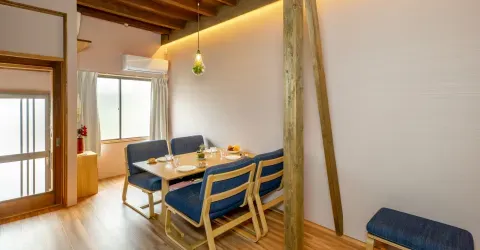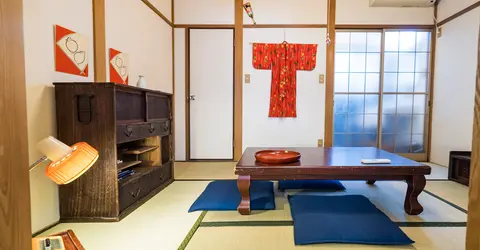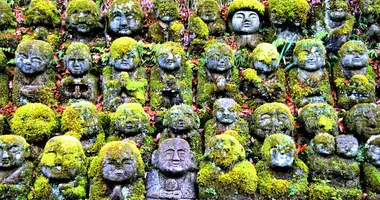Kodaiji Temple 高台寺
Located in a beautiful part of Higashiyama Ward, Kodaiji sits atop a slight hill. The temple is a jewel of Momoyama Period architecture.
Kodaiji Kyoto
History of Kodaiji
The temple was established in 1605 by the legendary Nene (Kodai-in), the widow of Toyotomi Hideyoshi in honor of her late husband. It was financed by Tokugawa Ieyasu, who was responsible for later wiping out the family of Toyotomi.
Nene became a nun (ama) on the death of her husband to pray for his soul in the afterlife and she lived here at Kodaiji until her death in 1624 at age 76.
Fine lacquerware images of Nene and Hideyoshi adorn the Main Hall.
Much of the Kodaiji complex was destroyed in 1789 by fire. The only buildings to survive were Otama-ya, Kaisan-do (The Founder's Hall), Kangetsu-dai, Kasa-sai, and several others. The Kaisan-do contains paintings by artists from the Kano and Tosa schools.
Kangetsu-dai is a roofed bridge that was brought from Fushimi Castle and was used as a moon-viewing platform by Hideyoshi. The bridge crosses a stream and Engetsu Pond and connects to the Kaisan-do and Tamaya.
Sanko Joeki
The Kaisando (sometimes spelled Kaison-do) was dedicated to the founding priest of Kodaiji, Sanko Joeki, formerly the head priest at Kenninji Temple.
The walls and pillars are decorated with paintings by artists from the Tosa and Kano schools of painting including a superb dragon by Kano Eitoku (1543-90).
Gorgeous panels from Hideyoshi's flagship and his wife's carriage decorate the ceiling.
Tamaya
The Tamaya is a Momoyama Period marvel noted for its tatamaki-e done in gold. The building holds an image of Kannon and a miniature shrine dedicated to Hideyoshi and one to his wife Nene.
Enshu Kobori
Within the Kodaiji temple grounds, there is a lovely bamboo grove and several tea houses. The gardens at Kodaiji are the work of Enshu Kobori and the teahouses were designed by the legendary tea master Sen-no-Rikyu or his disciples.
The gardens contain several ponds. One has an island in the shape of a turtle and one of the stone gardens represents a crane - both these creatures symbolize longevity.
Omotemon Gate
The Omotemon Gate was brought here from Fushimi Castle, built by Hideyoshi, along with two summer houses: Shigure-tei (Shower of Rain) and Kasa-tei (Umbrella), which stand on a hill behind the mortuary chapel (Otamaya) containing the remains of Hideyoshi and Nene, a building known for its raised lacquer work (tatamaki-e) done in gold and silver.
Shigure-tei
Shigure-tei, designed by Toyobo Sochin, was originally built for Hideyoshi's outlandish tea ceremony in 1587 at Kitano Tenmangu Shrine, when he invited the whole world to attend.
Another fine tea ceremony house is Iho-an (The Cottage of Lingering Fragrances).
The view of other nearby Kyoto temples and down into the city center is stunning. Kodaiji is illuminated in the spring, autumn and late summer and open to the public for special evening viewing sessions.
Nearby
A visit to Kodaiji can be combined with trips to Maruyama Park, Ryozen Kannon, Kenninji Temple, Yasaka Jinja and Kiyomizudera. The Okazaki museum area and Heian Shrine are to the north across Sanjo dori.
The famous, Michelin starred restaurant Kikunoi is close by.
This area of Kyoto is one of its most famous districts and there are numerous hotels, ryokan and guesthouses in the vicinity.
Address, timetable & access
Kodaiji Temple
Address
Shimogawara-cho, Higashiyama-ku Sakyo-ku,
605-0825
Japan
Phone
+81 (0)75 561 9966Timetable
9 a.m - 5.30 p.m.Price
600 yen; high school and junior high school age students 250 yen. Entry fee includes the Sho Museum.Access
Kodaiji Temple is a 10-minute walk from the Higashiyama Yasui bus stop. Bus #206 from Kyoto Station. From Hankyu Kawaramachi Station or Keihan Shijo Station take bus #207 to the Higashiyama Yasui bus stop.Website
http://www.kodaiji.com/































